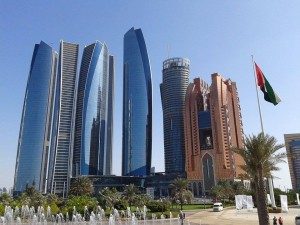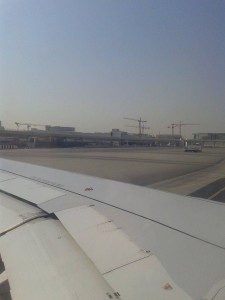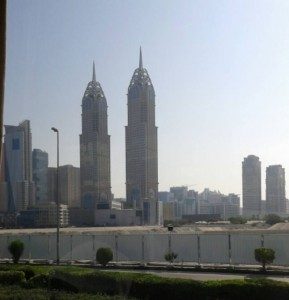Last week, we completed the international excursion component of our adventure in Jordan. Our planned excursion to Istanbul was changed to a trip to the United Arab Emirates following bombings in Ankara a few weeks ago. We visited 4 of the 7 Emirates in an attempt to understand modernization and social change in the UAE (Dubai, Abu Dhabi, Ajman, and Shariqa). What we did not get to do in the UAE is practice our Arabic.
The difference from arriving at Dubai Int’l is a 180 from arriving at Queen Alia Int’l in Jordan. A sapphire blue coast greets you in the UAE, peppered with yachts and container ships ; the city looks orderly from above, everything organized into neat sections and communities connected with wide roads and highways; there is GREEN, lawns, trees, gardens. After being in a country with water shortage for 2 months, seeing irrigated lawns was a bit of a surprise (and I live in Florida). Leaving the airport was stepping–to quote an SIT colleague–“into Tomorrowland.” Every building is a work of art. Buildings are built to look like a ship’s sail, an airplane, a glass  truncated pyramid, and even a fleet of ships sailing in from the distance (a three-skyscraper hotel complex). Another colleague commented–and I agree–that being an architect in Dubai has to be the coolest job there is. It was interesting to see, within 5 minutes of arrival, a Dubai-isized replica of the Chrysler Building and the Empire State Building (later in my trip, I saw Dubai’s “World Trade Center,” also with two identical towers). I wasn’t sure what to make of these then–and I’m still not.
truncated pyramid, and even a fleet of ships sailing in from the distance (a three-skyscraper hotel complex). Another colleague commented–and I agree–that being an architect in Dubai has to be the coolest job there is. It was interesting to see, within 5 minutes of arrival, a Dubai-isized replica of the Chrysler Building and the Empire State Building (later in my trip, I saw Dubai’s “World Trade Center,” also with two identical towers). I wasn’t sure what to make of these then–and I’m still not.
We drove for 20 or 30 minutes and saw no end to the designer skyscrapers, banks, the space-ship-looking metro stations, or car dealerships. I made it my mission to find the other side of Dubai. Not everyone, I was sure, could live here and with such opulence. I succeeded with the help of 4 colleagues; our 4th day in the UAE was a free day, which we could use to go where we wanted to be tourists, scholars, or some combination of the two. My 4 friends and I ventured to the Heritage Center, a waterfront complex of museums, traditional markets, and preserved historic buildings. This is Dubai’s cradle, a homage to the city’s roots as a creek-side fishing and pearling village. Even though we were exactly where Dubai was born, the area felt sterile, tailored and preserved for tourists. My friend Kaylah suggested we cross Dubai Creek, into what is known as Old Dubai. Our group agreed and–after a delicious Indian lunch–we boarded a refurbished fishing boat to cross the water.
On the other side: welcome to India! We definitely felt as though we had left Dubai and the Arab World as a whole. Even the tourists we encountered were from India, Pakistan, and Thailand (among other countries in that same region). Gone were the sparkling towers, fountains, Imaratis driving European sportscars, and Western tourists (except for our small group, which stuck out like a sore thumb). This is what I wanted to see, where most people in Dubai live, what the people and the culture are like away from foreign gaze. Buildings were generally shops and eateries on the first floor and humble residences on the floors above. The city is dense, with narrow alleys between buildings, small and cluttered streets, and sidewalks flooded with people. Walking through brought back memories of downtown Amman and downtown Caracas (for those of you who don’t know, I grew up in Venezuela). Sadly, I have no pictures of our adventures in Old Dubai. We already looked enough like tourists; the last thing we needed was to walk around, phones drawn, photographing miscellaneous things. I also did not feel completely safe, so awareness of my surroundings took priority. My friend Ronald, on the other hand, was completely at home; he is from Singapore and speaks fluent Hindi, Mandarin, and Bengali. He befriended many a shopkeeper and introduced us to some traditional Indian sweets for an afternoon pick-me-up. Having found what we were seeking, we decided to cross the creek again and spend the rest of the day as tourists, hanging our scholar hats until the next day.
On a different night, 4 different friends and I went on an adventure to the Filipino sector of Dubai (the city has areas that are clearly Indian, clearly Filipino, clearly Imarati, among other ethnic groups. Some colleagues have called the UAE a “diverse” country and a “melting pot of cultures,” but I see it as more of a mixed grill platter–see image below–with different ethnicities clustered together, separate from each other). Our goal was to find authentic Filipino food, which we found. In a strict sense, our mission was a success, since we found Filipino food. That said, I doubt I will ever seek it out again. I write about this experience, though, not to share my thoughts on tuna casserole and rice wrapped in plantain leaves, but to open a reflection about human capital in the UAE. I knew the UAE has a lot of foreign labor, but picking up a copy of the local Filipino newspaper at the restaurant got me thinking about the implications of this labor model.
The paper included a Q&A section authored by a local lawyer who handled mainly labor and immigration cases. I perused the section, reading the anecdotes of confused and disgruntled Filipinos trying to figure out how to renew their work permits or remain in the country after being fired. I got to thinking that not only is an overwhelming majority of UAE’s (unskilled and semi-skilled) labor foreign, but its also on a temporary basis. Companies can hire foreign workers and bring them on a work visa, but it seems that in some (most, I suspect) cases, these visas are temporary. Is this healthy for an economy that (though developed) is still growing? If 80% of your population is foreign and a large portion of that is transient, how much income is being lost to remittances? None of this matters today, since the UAE has oil reserves for the foreseeable future, but this labor system should be as temporary as its participants if the Emirates are to be sustainable when their oil depletes (or if oil prices continue to drop).
On the plane, as we departed the UAE, I was able to snap this picture, which depicts another important aspect of the culture of the modern UAE: aggressive growth and modernization. Construction cranes are as common a sight as skyscrapers and Maseratis. I consider the UAE a modern country (I am still undecided on whether I consider it developed, since I did not explore education or health enough), and in this case, aggressive modernization has brought with it rapid social change that will certainly bury what little remains of the UAE’s Arab roots in the near future.
PS this was a week-long adventure with dense daily itineraries, so there are many more experiences than what I’ve described here. Happy to provide additional stories or more reasoning for my thoughts if there is interest. Just ask!

